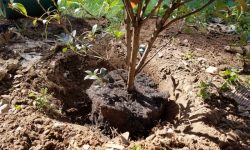Dogwood trees have long been admired for their graceful form and breathtaking seasonal displays. With delicate spring blossoms, lush green foliage, and striking autumn colors, they bring elegance and charm to any garden. Their beauty is matched by versatility, as dogwoods thrive in both formal landscapes and natural woodland settings, making them a favorite among gardeners.
Planting dogwoods correctly is the key to unlocking their full potential. From selecting the right location to preparing nutrient-rich soil and caring for young trees, every detail matters. When these steps are followed, dogwoods reward you with vibrant blooms, strong growth, and lasting seasonal color. Understanding how to plant them properly ensures that your garden will enjoy their timeless beauty year after year.
Understanding Dogwood Trees Before Planting

Dogwood trees belong to the genus Cornus and are native to many regions across North America, Europe, and Asia. Known for their ornamental value, they produce clusters of white, pink, or red blossoms in spring, followed by lush green leaves and attractive fall colors. Some species even bear bright red berries that add winter interest and provide food for birds. Their year-round beauty makes them an ideal addition to both urban gardens and natural landscapes.
Before planting, it is important to understand the growth habits of dogwoods. Most varieties prefer partial shade, especially in warmer climates, where intense afternoon sun can stress the tree. They thrive in slightly acidic, well-drained soils that retain consistent moisture. Dogwoods are relatively small compared to many landscape trees, usually reaching 15 to 30 feet in height, making them suitable for yards of varying sizes. This modest size also allows them to complement other shrubs and perennials in a mixed planting design.
In addition to their ornamental charm, dogwoods hold ecological value. Their blooms attract pollinators such as bees and butterflies, while their berries provide food for wildlife. Because they are sensitive to environmental stress, understanding their needs before planting is essential for long-term success. Choosing the right species and considering local conditions can prevent problems later on. By learning about their natural preferences and potential challenges, gardeners lay the foundation for healthy growth, vibrant flowers, and a stunning display that endures through the seasons.
Choosing the Right Variety of Dogwood Tree
Selecting the right variety of dogwood is the first step toward ensuring vibrant blooms and long-term success. Dogwoods come in several species and cultivars, each with unique characteristics. Flowering dogwood (Cornus florida) is one of the most popular choices, prized for its large white or pink blossoms in spring and brilliant red foliage in autumn. Kousa dogwood (Cornus kousa), native to Asia, blooms slightly later and offers excellent disease resistance, making it a strong option for gardeners in areas prone to fungal issues.
When choosing a dogwood variety, climate plays an essential role. Flowering dogwoods thrive in temperate regions with cool winters and warm summers. Kousa dogwoods perform well in slightly warmer areas, while Pacific dogwoods (Cornus nuttallii) are better suited for the West Coast. Some hybrid varieties combine the best features of different species, offering improved disease resistance, diverse flower colors, and adaptable growth habits. Considering local conditions helps prevent unnecessary challenges and ensures trees establish quickly in your landscape.
Aesthetic preferences also guide variety selection. If you want showy spring blossoms, Cornus florida or Cornus kousa may be ideal. For striking fall foliage, hybrids like Cornus × rutgersensis provide rich seasonal color. Gardeners seeking year-round appeal may opt for evergreen dogwoods, which keep their foliage even in winter. Matching the tree’s features with your garden design ensures not only beauty but also long-lasting health. With the right choice, your dogwood will thrive for decades, becoming a centerpiece of seasonal charm and ecological value.
Best Time to Plant Dogwood Trees
Planting Dogwoods in Cooler Zones (Zones 3–5)
In cooler regions, such as Zones 3 to 5, the best time to plant dogwoods is early spring after the ground has thawed. Planting at this time allows young trees to establish roots before the hot summer arrives. Avoid late fall planting in these zones, as the cold winters can damage undeveloped root systems and reduce survival rates. Choosing a sheltered site helps protect trees from harsh winds and late frosts. Gardeners should also consider using windbreaks or planting near other structures to provide added protection.
Spring planting ensures that dogwoods benefit from ample rainfall, reducing the stress of frequent watering. As temperatures warm gradually, the trees adapt well to their environment, producing healthier growth. Adding organic matter to the soil before planting helps improve drainage while retaining enough moisture for young roots. By giving them a full growing season, gardeners in cooler zones set the foundation for vibrant blooms the following spring. With consistent watering, mulching, and pest monitoring, these dogwoods thrive despite shorter summers and colder winters.
Planting Dogwoods in Moderate Zones (Zones 6–7)
In Zones 6 and 7, both early spring and early fall are good times for planting dogwoods. Spring planting allows trees to settle before summer heat, while fall planting gives roots time to develop before winter dormancy. In both cases, planting when soil is moist but not waterlogged is important for success. Preparing the soil with compost ensures steady nutrient supply during the establishment phase. Gardeners should also test soil pH, as dogwoods prefer slightly acidic conditions, and amend the soil if needed to encourage healthy root growth.
Fall planting in these zones often proves advantageous because cooler temperatures reduce stress and rainfall is more consistent. Root systems continue to grow underground even as the tree enters dormancy, giving them a head start for spring. Mulching around the base insulates roots and keeps soil moisture stable through winter. Gardeners should avoid fertilizing right after planting to prevent stressing the tree and instead wait until the following spring. Providing partial shade and monitoring for early pests or fungal signs further supports growth. With careful seasonal timing, dogwoods in moderate climates adapt quickly, growing strong roots and blooming reliably for many years.
Planting Dogwoods in Warmer Zones (Zones 8–9)
In warmer zones, such as 8 and 9, fall is the ideal season for planting dogwoods. Planting in early fall gives young trees several months to establish roots before facing the intense heat of summer. Spring planting in these zones often stresses trees because of sudden temperature spikes and less predictable rainfall. To reduce transplant shock, plant during cooler mornings or evenings instead of peak midday heat. Choosing disease-resistant dogwood varieties is also recommended in these regions, since higher humidity and warmth can increase the risk of fungal problems like powdery mildew or anthracnose. Good soil preparation with organic matter ensures better water retention and root support during the establishment stage.
By planting in fall, gardeners provide cooler soil conditions that encourage steady root development. Adequate mulching helps conserve soil moisture and shields roots from heat fluctuations. Since dogwoods prefer partial shade, placing them in areas protected from afternoon sun is critical. Gardeners should water consistently until roots are well established, especially during dry winters. Regular monitoring for signs of heat stress or pests will help ensure the trees thrive. With thoughtful placement, soil care, and autumn planting, dogwoods adapt more easily and deliver healthy blooms, even in regions where summers are long, hot, and demanding.
How to Prepare the Planting Site for Dogwoods
Preparing the planting site properly is one of the most important steps to ensure dogwoods thrive in your garden. These trees prefer well-draining, slightly acidic soil that is rich in organic matter. Before planting, test the soil’s pH and adjust it if necessary, aiming for a range between 5.5 and 6.5. Amending heavy clay or sandy soils with compost or leaf mold improves structure, fertility, and drainage. A planting site with healthy soil not only encourages strong root growth but also supports long-term resistance against stress and disease.
Equally important is selecting the right location. Dogwoods naturally grow as understory trees, so they perform best in areas that receive morning sun and afternoon shade. Too much direct afternoon sunlight can scorch leaves, while deep shade may reduce flower production. Choose a spot with good air circulation to reduce the risk of fungal diseases but avoid areas exposed to strong winds, which can stress young trees. Planning ahead and matching the site to the tree’s natural preferences provides the best chance of success.
Once the soil and location are ready, mark out the planting hole at least twice as wide as the tree’s root ball but no deeper than its height. This allows roots to spread outward more easily while preventing the trunk from sitting too low, which could lead to rot. Removing grass, weeds, or other competing plants around the planting area also reduces stress on young dogwoods. With careful preparation, the site becomes a welcoming environment where dogwoods can establish quickly and reward you with healthy growth and vibrant blooms.
Planting Dogwoods Step by Step Guide
Preparing the Tree for Planting
Before you plant a dogwood, it is important to start with healthy material. Purchase your tree from a trusted nursery, making sure the root system is firm and not tightly wound in the pot. For container-grown trees, gently remove the plant and check the roots. If they circle around the root ball, loosen them slightly to encourage outward growth once in the ground. Bare-root trees should be soaked in water for a short period, about an hour, to help them rehydrate before planting. This preparation reduces transplant shock and allows the tree to adjust more smoothly to its new environment. Checking the soil pH in advance is also essential, since dogwoods prefer slightly acidic conditions between 5.5 and 6.5.
Gathering the right tools and supplies will make the process easier and more efficient. A sharp spade, pruners for trimming damaged roots, mulch, compost, and gloves are all helpful. Preparing the planting site in advance by removing weeds or grass around the chosen area ensures the tree will not face immediate competition for nutrients. When the tree and site are both ready, you create the best foundation for healthy growth. Proper preparation may seem like a small step, but it has a lasting effect on how quickly and strongly a dogwood will establish itself in the garden.
Digging the Hole and Planting the Tree
The actual planting process is where careful technique makes the most difference for a dogwood’s long-term success. Begin by digging a hole that is at least twice as wide as the tree’s root ball but not deeper than its height. Dogwoods dislike being planted too deeply, so ensure that the root collar—the area where the trunk meets the roots—sits level with or slightly above the surrounding soil. Placing the tree too low can suffocate roots and lead to rot. Position the tree carefully in the hole, spreading out the roots naturally. This step ensures they will grow outward rather than continuing to circle as they might in a pot.
Backfill the hole using the soil you removed, mixed with organic compost to provide nutrients and improve structure. Gently firm the soil in layers, avoiding heavy compaction, which could restrict water and air movement. After filling, water the tree thoroughly to settle the soil around the roots and remove any hidden air pockets. Form a shallow basin around the planting site to catch irrigation water and direct it toward the root zone. Finally, apply mulch five to eight centimeters thick, but keep it a few centimeters away from the trunk to prevent rot. Correct planting technique not only helps the tree adjust quickly but also sets the stage for decades of healthy growth.
Caring for Dogwoods After Planting
Once your dogwood is in the ground, aftercare becomes the key to ensuring it thrives. Water deeply at least once a week during the first year, adjusting based on rainfall and soil conditions. Unlike shallow sprinkling, deep watering encourages roots to grow downward, making the tree more resilient against drought. Mulch around the base helps retain soil moisture, regulate temperature, and suppress competing weeds. Be sure to refresh the mulch annually, maintaining a layer that protects without smothering the trunk. In regions with hot summers, providing temporary shade during the afternoon can help reduce stress for newly planted trees.
Staking may be necessary if the site is exposed to strong winds, but it should be done lightly and removed within a year once the tree stabilizes. Avoid fertilizing immediately after planting, as this can overwhelm fragile new roots. Instead, wait until the following growing season if soil tests show nutrient deficiencies. Limit pruning to removing damaged or diseased branches, saving major shaping until the tree is established. Monitor regularly for pests like borers or fungal diseases, which can be more common in stressed young trees. With attentive care during the first few years, your dogwood will develop a strong root system, making it capable of producing abundant flowers and providing lasting beauty in your landscape.
Common Mistakes to Avoid When Planting Dogwoods
One of the most frequent mistakes gardeners make is planting dogwoods too deep. When the root collar is buried under soil, the tree struggles to breathe, leading to rot and weak growth. Always ensure the root flare is visible above the soil line. Another common error is neglecting to loosen circling roots in container-grown trees. If roots are left compacted, they may continue to wrap around themselves instead of spreading outward, which limits stability and nutrient absorption. Planting in heavy, poorly drained soil without amending it is another pitfall that often results in root rot. Adding compost or leaf mold to improve drainage and aeration is essential before planting.
Improper watering practices can also cause problems. Frequent shallow watering encourages surface roots, making the tree less drought tolerant, while overwatering may suffocate the roots. Deep weekly watering is far more effective. Using too much mulch piled against the trunk, often called “volcano mulching,” can trap moisture against the bark and invite pests or disease. Finally, fertilizing immediately after planting is a mistake that can stress new roots. By avoiding these errors and following proper planting methods, gardeners can give dogwoods the strongest start possible.
Caring for Dogwoods Year-Round
Watering Dogwoods Properly
Consistent watering is one of the most important aspects of dogwood care, especially during the first few years after planting. Young trees need deep watering at least once a week, ensuring the soil is moist down to the root zone rather than just at the surface. Shallow watering encourages weak roots that remain near the soil’s surface, making the tree more vulnerable to drought stress. Established dogwoods become more resilient but still benefit from regular watering during dry periods, particularly in hot summer months. Rainfall alone may not be enough, so supplemental irrigation helps the tree maintain steady growth.
Using a soaker hose or drip irrigation system is often more effective than overhead sprinkling, as it delivers water directly to the roots while minimizing leaf wetness, which can lead to fungal problems. Morning watering is best because it gives the tree time to absorb moisture before the day’s heat. Gardeners should always check soil moisture before watering, avoiding soggy conditions that cause root rot. Striking a balance—providing enough water without overdoing it—ensures the dogwood develops a healthy root system and produces vibrant blooms year after year.
Fertilizing Dogwoods for Healthy Growth
Fertilizing dogwoods should be done with care, since too much fertilizer can damage delicate roots or encourage excessive leafy growth at the expense of flowers. For newly planted trees, avoid adding fertilizer during the first growing season, as roots are still establishing and can be easily stressed. Starting in the second year, apply a balanced, slow-release fertilizer in early spring before new growth emerges. This gives the tree a steady supply of nutrients to support budding leaves and flowers.
Dogwoods also respond well to organic soil amendments like compost or well-aged leaf mold, which improve fertility naturally while enhancing soil structure. Avoid high-nitrogen fertilizers, which may produce lush foliage but reduce bloom production. Instead, look for blends with balanced or slightly higher phosphorus content to support flowering and root health. Fertilizing again in mid-summer can be helpful in nutrient-poor soils, but never fertilize late in the season, as this may stimulate new growth vulnerable to winter frost. By feeding dogwoods wisely, gardeners encourage steady growth, stronger branches, and abundant blossoms.
Mulching Around Dogwoods
Mulching plays an essential role in keeping dogwoods healthy throughout the year. A two- to three-inch layer of organic mulch, such as shredded bark, pine needles, or leaf mold, helps regulate soil temperature and conserve moisture. This is especially important in summer when heat and evaporation can stress young trees. Mulch also suppresses weeds, reducing competition for water and nutrients around the root zone. By insulating the soil, mulch protects shallow roots from extreme temperatures in both hot summers and cold winters.
When applying mulch, it’s important to spread it evenly around the base of the tree, extending outward to the drip line if possible. However, mulch should never touch the trunk, as this can trap moisture against the bark and create conditions for pests, disease, or rot. Refreshing mulch annually ensures continued benefits and keeps the soil environment stable. Over time, organic mulch also breaks down, enriching the soil with nutrients. With proper mulching, dogwoods experience less stress, maintain steady moisture, and develop stronger root systems, which all contribute to healthier growth and reliable flowering.
Pruning Dogwoods for Shape and Health
Pruning dogwoods is necessary to maintain their graceful shape, encourage healthy growth, and prevent disease. The best time to prune is late fall or winter when the tree is dormant, reducing stress and minimizing the risk of sap loss or pest attraction. Begin by removing any dead, damaged, or diseased branches, which can sap the tree’s energy and invite further problems. Crossing branches should also be pruned to prevent rubbing wounds, which create entry points for pathogens. Keeping the canopy open improves air circulation and reduces the likelihood of fungal infections.
For shaping purposes, prune sparingly, as dogwoods naturally grow into an attractive form. Avoid heavy pruning, which may weaken the tree and reduce the next season’s flowers. Instead, focus on gentle thinning cuts that enhance the tree’s structure. Use sharp, clean pruning tools to make smooth cuts, which heal faster and lower the risk of disease. Suckers growing from the base should also be removed to direct energy into the main trunk. With regular but careful pruning, dogwoods remain healthy, balanced, and beautiful, rewarding gardeners with their distinctive blossoms year after year.
Protecting Dogwoods from Pests and Diseases
Common Pests Affecting Dogwoods
Dogwoods can be targeted by several pests, with dogwood borers being one of the most serious threats. These insects tunnel into the trunk and branches, weakening the tree and making it more vulnerable to breakage or disease. Signs include sawdust-like material at the base of the trunk and dying branches. Aphids and scale insects are also frequent problems, feeding on sap and causing leaf curling, yellowing, and reduced vigor. In some cases, spider mites may infest leaves during hot, dry periods, leading to stippling or premature leaf drop.
To manage pests, early detection is crucial. Regularly inspect the trunk, branches, and undersides of leaves for signs of infestation. Horticultural oils or insecticidal soaps can control aphids and scales, while maintaining tree vigor with proper watering and mulching helps reduce susceptibility to borers. For severe infestations, professional treatment may be necessary. Avoiding trunk injury, such as lawn mower damage, is another key prevention method since wounds are entry points for borers. With consistent monitoring and prompt action, pest problems can be minimized, keeping dogwoods strong and flourishing.
Common Diseases in Dogwoods
Dogwoods are also vulnerable to several fungal diseases, with dogwood anthracnose being the most damaging. This disease causes brown leaf spots, twig dieback, and in severe cases, tree death. Powdery mildew is another common issue, appearing as a white coating on leaves that hinders photosynthesis and reduces overall vigor. Leaf spot diseases may also occur, especially in wet, humid conditions, leading to premature defoliation. These problems are often worsened when dogwoods are stressed by poor planting conditions or drought.
Preventing disease starts with good cultural practices. Planting dogwoods in well-drained soil with adequate air circulation reduces the risk of fungal growth. Watering at the base of the tree rather than overhead helps keep foliage dry, further lowering the chance of infection. Fungicidal sprays may be used in severe cases, but prevention through proper site selection, spacing, and pruning is far more effective. Regularly removing fallen leaves and debris also limits the spread of fungal spores. By creating favorable growing conditions and monitoring for early signs, gardeners can protect their dogwoods from disease and ensure they remain healthy and beautiful year after year.
Common Mistakes to Avoid During Planting Dogwood
Planting Too Deep or Too Shallow
Improper planting depth is one of the most common reasons young dogwoods fail to thrive. When planted too deep, the root collar becomes buried under soil, restricting oxygen flow and creating conditions for rot. A deeply planted tree may appear healthy at first but often declines over time as roots suffocate. On the other hand, planting too shallow leaves roots exposed, drying them out quickly and making the tree unstable. Both mistakes reduce the dogwood’s ability to establish a strong root system.
The solution is to always position the tree with the root flare visible just above the soil surface. The hole should be no deeper than the root ball’s height but at least twice as wide, encouraging roots to spread outward. Careful attention to this detail prevents long-term stress and gives the tree a solid foundation. Checking soil levels after watering ensures the tree hasn’t settled deeper than intended. Proper depth at the time of planting is critical to the dogwood’s survival and future growth.
Poor Soil Preparation and Drainage
Dogwoods are highly sensitive to poorly drained soils, and planting them in heavy clay or compacted ground is a mistake many gardeners make. Excess water around the roots can quickly lead to root rot, fungal infections, and reduced vigor. Without soil preparation, even the healthiest young tree will struggle to adapt, showing symptoms like yellowing leaves and stunted growth. Ignoring soil pH is another oversight, as dogwoods prefer slightly acidic soil. Planting in alkaline or unamended soil often limits nutrient uptake.
To avoid this, prepare the site by incorporating organic matter such as compost, pine bark, or leaf mold into the soil. This improves both drainage and fertility, giving roots an ideal environment to expand. Conducting a simple pH test before planting ensures the soil falls within the preferred range of 5.5 to 6.5. If adjustments are needed, sulfur can lower alkalinity while lime raises acidity. By addressing soil quality before planting, gardeners prevent common issues and provide dogwoods with conditions that promote long-term health and growth.
Watering Mistakes After Planting
Improper watering is another frequent error when establishing dogwoods. Some gardeners water too little, causing roots to dry out before they can extend into the surrounding soil. Others overwater, leaving the soil saturated and depriving roots of necessary oxygen. Both extremes create stress and make the tree vulnerable to pests and diseases. Shallow watering is another mistake, as it only moistens the surface, encouraging weak, shallow roots that cannot withstand heat or drought.
The best approach is deep, consistent watering. Newly planted dogwoods should be watered once or twice a week, depending on rainfall, with enough water to penetrate deeply into the root zone. Using a soaker hose or drip irrigation ensures water reaches the roots without wetting the foliage, which can encourage fungal disease. Over time, as the tree becomes established, watering can be reduced, but monitoring soil moisture is still essential. Correct watering practices help build a resilient root system and ensure the dogwood adapts well to its new environment.
Misusing Mulch and Fertilizer
Mulch is often misapplied around dogwoods, leading to more harm than benefit. A common mistake is piling mulch high against the trunk, sometimes called “volcano mulching.” This traps moisture against the bark, inviting rot, insects, and fungal diseases. Applying mulch too thickly can also prevent water from reaching the roots, defeating its purpose. Fertilizer misuse is another issue—many gardeners add fertilizer immediately after planting, which can burn delicate roots or push leafy growth at the expense of flowers.
To use mulch correctly, spread a two- to three-inch layer evenly around the base, keeping it several inches away from the trunk. Mulch should extend outward to cover the root zone, helping retain moisture and regulate soil temperature. Fertilizer should be delayed until at least the second growing season, allowing roots time to establish. When applied, use a balanced, slow-release formula in early spring. Avoid high-nitrogen blends that may weaken the tree. By applying mulch and fertilizer properly, gardeners support healthy establishment without causing unnecessary stress.
FAQ About Planting Dogwood Trees
When is the best time to plant a dogwood tree?
The ideal time is early spring or fall when temperatures are mild, and the soil is workable. These seasons reduce stress on the young tree, allowing roots to establish before facing summer heat or winter cold. Avoid planting in extreme weather conditions for the best survival rate.
How much sunlight do dogwood trees need?
Dogwoods thrive in partial shade, especially in hotter climates where intense afternoon sun can scorch their leaves. In cooler regions, they can handle more direct sunlight. Ideally, provide morning sun and afternoon shade to ensure balanced growth, healthy foliage, and abundant seasonal blooms every year.
How often should I water my newly planted dogwood?
During the first year, water deeply at least once or twice a week, depending on rainfall. The goal is to keep the soil consistently moist but not soggy. Mulching around the base helps conserve moisture and regulate temperature, reducing the stress on young roots as they establish.
Do dogwood trees need fertilizer after planting?
Fertilization is not necessary immediately after planting. Over-fertilizing can damage tender roots and encourage weak growth. Wait until the second growing season, then apply a balanced, slow-release fertilizer in early spring. This ensures strong development without overwhelming the tree during its delicate establishment stage.
What pests or diseases commonly affect dogwoods?
Dogwoods can be vulnerable to powdery mildew, leaf spot, and dogwood anthracnose, especially in humid conditions. Pests like borers and scale insects may also cause problems. Planting in well-drained soil, providing proper air circulation, and monitoring regularly for early symptoms helps protect the tree from serious damage.
Final Conclusion
Planting a dogwood tree can be a rewarding experience when done with care and attention. By choosing the right site, preparing the soil properly, and avoiding common mistakes, you set the foundation for healthy growth and stunning seasonal displays. Dogwoods are cherished for their delicate blossoms, vibrant fall foliage, and graceful presence in the landscape. However, their success depends heavily on proper planting and early care. When you plant at the right depth, ensure good drainage, and provide balanced sunlight and water, you give your dogwood the best chance to thrive for decades. With patience and dedication, your dogwood tree will not only enhance the beauty of your garden but also become a long-lasting centerpiece admired by generations.






